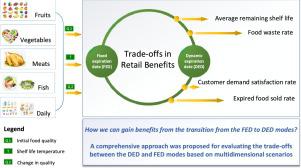Resources, Conservation and Recycling ( IF 13.2 ) Pub Date : 2022-07-20 , DOI: 10.1016/j.resconrec.2022.106511 Yifeng Zou , Junzhang Wu , Guanghai Liu , Mirco Piron , Andrea Fedele , Scipioni Antonio , Alessandro Manzardo

|
A significant challenge in today's food system is variable and unknown food quality affected by various temperatures, resulting in unreliable fixed expiration dates (FED) printed on food packaging. The dynamic expiration date (DED) mode is proposed as an alternative to the FED mode; however, practitioners must guard against some major uncertainties when setting expiration dates (shelf life) for fresh food. As such, we firstly developed a computer-simulated experiment based on a shelf life prediction model for multiple scenarios (i.e., fresh food's initial quality, quality change rate, and shelf temperature) to evaluate potential retail benefits of both date modes. The results show that the DED mode is a promising approach; yet a significant difference in retail benefits emerged between the DED and FED modes. On the one hand, the DED mode could reduce food waste by 10.02% at low temperatures (0−8 °C), but it may increase food waste by 15.94% and 31.71% under the temperature abuse conditions of 12−18 °C and 20−28 °C, respectively. On the other hand, the expired food sold rate within the FED mode is influenced by shelf temperatures, quality change rate, and initial quality of fresh foods. A one-at-a-time perturbation analysis finds that fresh food's shelf life associated with food quality is particularly sensitive to the food waste rate and expired food sold rate in both date modes. This study supports the trade-offs in retail benefits between the two modes while encouraging retailers to proactively optimize DED use.
中文翻译:

检查不同到期日期模式的潜在零售利益的权衡:洞察多维场景
当今食品系统的一个重大挑战是受各种温度影响的可变且未知的食品质量,导致食品包装上印制的固定有效期 (FED) 不可靠。提出了动态到期日期(DED)模式作为 FED 模式的替代方案;但是,从业人员在设置新鲜食品的保质期(保质期)时必须注意一些重大的不确定性。因此,我们首先针对多种场景(即新鲜食品的初始质量、质量变化率和货架温度)开发了一个基于保质期预测模型的计算机模拟实验,以评估两种日期模式的潜在零售效益。结果表明,DED 模式是一种很有前途的方法;然而,DED 和 FED 模式之间的零售收益存在显着差异。一方面,DED 模式在低温(0−8 °C)下可以减少 10.02% 的食物浪费,但在 12−18 °C 和 20−28 °C 的温度滥用条件下,它可能会增加 15.94% 和 31.71% 的食物浪费, 分别。另一方面,FED模式下的过期食品售出率受货架温度、品质变化率和生鲜食品初始品质的影响。一次一个扰动分析发现,与食品质量相关的新鲜食品的保质期对两种日期模式下的食品浪费率和过期食品销售率特别敏感。这项研究支持两种模式之间的零售利益权衡,同时鼓励零售商主动优化 DED 的使用。


























 京公网安备 11010802027423号
京公网安备 11010802027423号